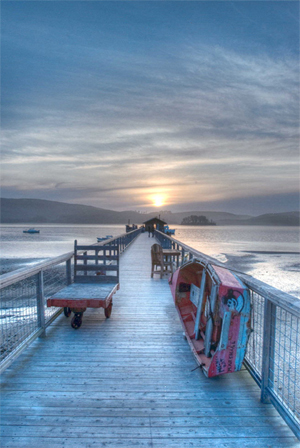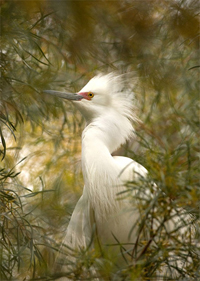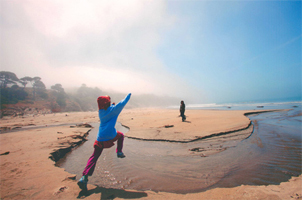Coast 4U Quarterly, Winter 2011
Amateur Photography Contest
| Kirke Wrench of Mill Valley won the 12th Annual Amateur Coastal Photography Contest, sponsored by the Coastal Commission and Fairmont Hotels & Resorts of California. He snapped the winning photo one evening when he took his wife, Patty, out to dinner at Nick's Cove just as the sun was going down. "I just happened to take my camera with me. I never imagined I would be taking an award-winning photograph that night," said Wrench. "I've never won a photo contest before," he added happily. For his prize, he selected a two-night stay in Sonoma County donated by the Fairmont Mission Inn & Spa. Wrench is a volunteer photographer for the National Park Service where he focuses on taking wildlife photographs in the Golden Gate National Recreation Area. Both the Mill Valley Herald and the Marin Independent Journal printed his prize-winning image. |
|
||
|
The winner in the category for Best Humorous Photo was Ralph Wessel of Cayucos (San Luis Obispo County), who
snapped a shot of elephant seals on the beach enjoying "gossip time." For his prize, he selected a two-night
stay at the Fairmont San Jose Hotel. |
|||
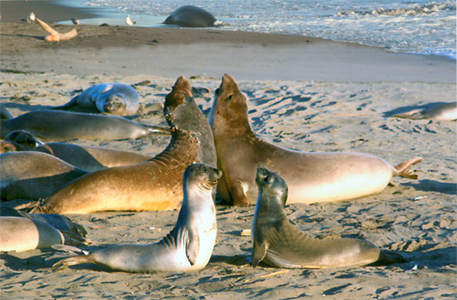
|
|||
"Gossip Time," Elephant Seals north of San Simeon, © Ralph Wessel |
|||
| Joan Sparks from Cupertino won second-place for her portrait of a snowy egret perched in a tree, which she says she photographed only because she luckily happened to look up and see it sitting there. |
|
||
| And the third-place photograph by Kurt Fuchs of San Francisco shows children playing on Bowling Ball Beach in Mendocino. |
|
||
This contest is open to everyone with photos of scenery, wildlife, or visitors to the California coast who makes less than half their income from photography. All winning photos and honorable mentions are displayed on our website.
Destination Series: PACIFIC GROVE
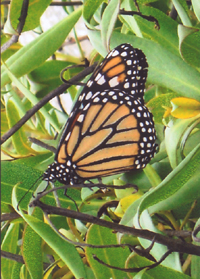
|
Monarch Butterfly, Pacific Grove Coast |
Beginning in October, hundreds of thousands of monarch butterflies overwinter in Pacific Grove in native Monterey pine trees and introduced eucalyptus trees, collectively called "butterfly trees." Kindergarten children, dressed as monarchs, welcome the returning butterflies each fall with a parade in town; call (831) 646-6540. Monarch viewing areas include a city-owned sanctuary of Ridge Road near Lighthouse Avenue and George Washington Park at Alder Street and Pine Avenue; the park also has a picnic area, restrooms, children's play facilities and a baseball field.
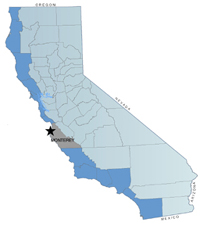 The community of Pacific Grove is proud of its scenic shoreline. A series of city parks follow the
blufftop above the town's rocky coast. The paved Monterey Bay Sanctuary Scenic Trail, serving bicyclists
and pedestrians, connects sites around Monterey Bay and runs through Pacific Grove as far west as
Lovers Point. From there to Point Pinos and beyond, the shoreline is publicly owned and bordered by a
shorefront path. Stairs at several locations allow access to Pacific Grove's pocket beaches. Offshore
waters are part of Monterey Bay National Marine Sanctuary. Blue-jacketed volunteer docents from Bay Net,
a Sanctuary affiliate, are often present along the Monterey Bay Sanctuary Scenic Trail, where they
provide information to visitors about marine resources.
The community of Pacific Grove is proud of its scenic shoreline. A series of city parks follow the
blufftop above the town's rocky coast. The paved Monterey Bay Sanctuary Scenic Trail, serving bicyclists
and pedestrians, connects sites around Monterey Bay and runs through Pacific Grove as far west as
Lovers Point. From there to Point Pinos and beyond, the shoreline is publicly owned and bordered by a
shorefront path. Stairs at several locations allow access to Pacific Grove's pocket beaches. Offshore
waters are part of Monterey Bay National Marine Sanctuary. Blue-jacketed volunteer docents from Bay Net,
a Sanctuary affiliate, are often present along the Monterey Bay Sanctuary Scenic Trail, where they
provide information to visitors about marine resources.
-Excerpt from Experience the California Coast, A Guide to Beaches and Parks from Monterey to Ventura, by the California Coastal Commission.
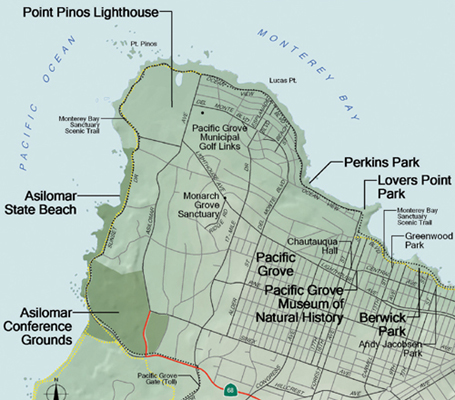
Find more information at
WHALE TAIL® License Plate Dollars at Work:
Eco-Education Program, Golden Gate Audubon Society
The WHALE TAIL® Grants Program distributes funds from sales of the WHALE TAIL® License Plate. The grants support programs that teach California's children and the general public to value and take action to improve the health of the state's marine and coastal resources. Adopt-A-Beach programs, as well as other beach maintenance and coastal habitat restoration projects that have an educational component, are also eligible for these grants. This grants program focuses on reaching communities that are currently poorly served in terms of marine and coastal education.
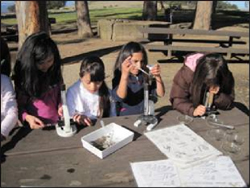 Each issue of the Coast4U Quarterly features one of our WHALE TAIL® Grant-funded projects. This issue we
feature the Eco-Education Program of the Golden Gate Audubon Society. For more examples of projects funded by
the WHALE TAIL® Grants Program, please visit the website.
Each issue of the Coast4U Quarterly features one of our WHALE TAIL® Grant-funded projects. This issue we
feature the Eco-Education Program of the Golden Gate Audubon Society. For more examples of projects funded by
the WHALE TAIL® Grants Program, please visit the website.
"Muchas gracias, disfrutamos mucho del viaje, sobretodo porque fue en mí idoma, español" wrote a mother to the Golden Gate Audubon Society: "Thank you very much; we greatly appreciate our trip, most of all because it was in my language, Spanish." This mother was expressing her gratitude to the Eco-Oakland Program, a year-round environmental education program, which along with the Eco-Richmond Program, is run by the Golden Gate Audubon Society.
Offered in both English and Spanish (translation into Spanish was a supported by WHALE TAIL® funding), these programs are designed to include whole families at urban, underserved schools in Oakland and North Richmond/San Pablo and emphasize hands-on learning, ecology, habitat restoration, and the protection of San Francisco Bay and local watersheds. Presentations in elementary classrooms and on field trips to local Bay shorelines cover watersheds, the importance of a healthy marsh, how pollution affects food chains in San Francisco Bay, and how the local community is connected to the marine environment. Students also help clean up trash and restore habitat.
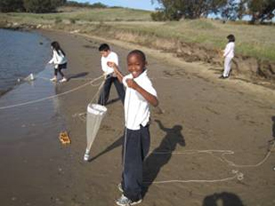
Additional funding from the WHALE TAIL® Grants Program has supported after-school marine ecology programs for students and their parents, as well as weekend field trips taking the children and their families to coastal sites such as Muir Beach. At the coast they enjoy activities including interpretive hikes, tidepool research, bird watching, beach cleanups, and learning about safe fish consumption. For quite a few families, this is their first trip to the ocean.
Golden Gate Audubon has been honored as a recipient of the Governor's Environmental and Economic Leadership Award, and the Outstanding Service Award by the North American Association for Environmental Education. For more information, please visit www.goldengateaudubon.org/education/eco-education-programs.
Beach Angels
"One Hour, One Beach, Once a Week"
Sales from the California Whale Tail® License Plate support a variety of environmental program aimed at providing education and volunteer opportunities focused on coastal conservation. This issue spotlights the Beach Angels of Santa Barbara, who are regular participants in the Adopt-A-Beach program. Read below to learn about how this group of college students is taking action to keep their neighborhood beaches clean.
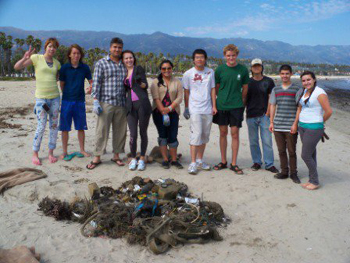 C4UQ: Who are the Beach Angels? What activities do they perform?
C4UQ: Who are the Beach Angels? What activities do they perform?
The Beach Angels are a volunteer group of students and faculty members from both SBCC and UCSB who have decided to meet on the weekends at the Stearns Wharf in Santa Barbara to clean their local beach. Every weekend, on Sunday, depending on when low tide is, we gather and work at the tide line for about 200 yards, cleaning an average of 50 - 100 lbs. each cleanup. Since much of the dangerous plastics and man-made trash are hidden at high tide, we always meet at low tide. With the help of our team, the Beach Angels have cleaned and hauled many objects out of the sand which are usually half-buried.
C4UQ: What kind of things do you find at your cleanups?
Among the usual cigarette butts, plastic bottles, and soda cans, we have also found several harmful items such as fishing lines, ropes, cell phone pieces, fiberglass boat pieces, tons of styrofoam, clothing, in which young dolphins can get stuck, tons of nylon boat ropes, electrical cords, foam from boat cushions, hypodermic needles and shotgun shells.
C4UQ: What have the Beach Angels achieved through these efforts?
Since July 5th 2009, we have removed over two tons of plastic trash out of the beach. Can you believe that? By keeping detailed data records of what we have removed and by photographing the trash taken off the beach, the Beach Angels hope to be able to spread the awareness toward solving the trash problem in the Pacific Ocean.
Despite the fact that we are focused on a little piece of the large West Coast shoreline, the Beach Angels are working hard on our idea, "One hour, one beach, once a week," so that we can present it to other City Colleges all along the California Coast. We are trying to create a working model with a revenue stream to make the work do-able at any and all colleges - using our great resource of college students whose futures rely upon clean water.
As a team, we think that if we can make all Northern and Southern California beaches have groups of people to go out and take the plastics OUT of the water, for as little as one hour a week, we would be really making a change on helping to end the terrible problem of plastics in the Pacific. We are trying to lessen "The Great Pacific Garbage Patch" at the center of the Pacific - a swirling pool of plastics caught up in circular currents called the North Pacific Gyre.
The Beach Angels may not be able to clean up the whole Pacific, or every beach, but tonight - when we go to sleep - we KNOW that at least 50 to 100 pounds of dangerous trash will NO LONGER HARM our beloved otters, fish, sea birds, dolphins, whales, and sea lions, BECAUSE our hands removed this trash today from the beach.
C4UQ: How can the public find out more information about the plastic pollution program?
We highly recommend going on YouTube and search for "Pacific Garbage Dump," "Plastics Sea Gulls," or "Plastics Birds" to realize the problems beaches are facing. Therefore, you will then see why the Beach Angels do this. Please join our group and help us spread the word.
C4UQ: How can others get involved in Beach Angel cleanups?
Times and dates for upcoming clean ups are posted on our Facebook wall and messaged to people who join the group.
Q & A with Matt Yurko
Restoration Education Coordinator
at Upper Newport Bay
Each issue of Coast4U Quarterly features an interview with an employee of the California Coastal Commission.
This issue features Matt Yurko, Restoration Education Coordinator at Upper Newport Bay. Read on to find out about the successful efforts Coastal Commission staff has achieved there, and the implications it have for habitat restoration sites throughout coastal California.
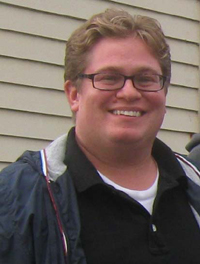 C4UQ: Why is habitat restoration vital for urban coastal wetlands?
C4UQ: Why is habitat restoration vital for urban coastal wetlands?
Urban coastal wetlands are under a great deal of stress from the development around them. Habitat restoration describes the attempt to return a landscape to the sustainable and diverse habitat it was before some disturbance altered it. The science of restoration ecology is relatively new, and experimentation is very important as we determine the best methods for achieving our goals. Doing what we can to restore the function of disturbed wetlands will bring back much of the value that has been lost. At some of the older restoration sites here at Upper Newport Bay, the changes in the plant communities, and subsequently the animal communities, have been significant.
C4UQ: How would you describe the particular predicament of Upper Newport Bay?
The Upper Newport Bay is unique in that it has never been cut off from its daily tidal flow. This means the marsh habitat is historically unaltered and very healthy compared to other local wetlands.
That said, the bay suffers from a long list of pollution in runoff including excess sediment, fertilizers, pesticides, car oil, and pet waste. Trash not only comes down from the 154-square mile watershed, but also from upstream in a high tide from the boats in Newport Harbor. Invasive plants are estimated to cover 47% of the bay, reducing its ability to support native wildlife. The effects of noise and air pollution from jet aircraft leaving John Wayne airport are felt every day.
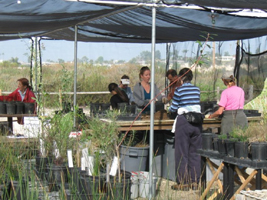
C4UQ: Will you describe the grounds and nursery of the Back Bay Science Center?
The Back Bay Science Center sits neatly on a human-made sand pile called Shellmaker Island. A previous industry dredged shells from the bottom of the bay and made them into an egg-shell-strengthening calcium supplement for chicken feed. Since then, the land has been restored from an industrial equipment yard to a native habitat and home to our office.
The native plant nursery is the heart of our program and houses 3,500 1-gallon pots. All of the plants are grown from seed or cuttings, and the plants are used directly at the restoration sites. We take great pride in growing the vast majority of the plants we need for our restoration work.
C4UQ: What is the Community-Based Restoration and Education Program, and what opportunities do you provide for volunteers?
Our work focuses on invasive plant removal throughout the year, native plant installation during the rainy season, and native plant propagation. The Community-Based Restoration and Education Program (CBREP) began in 2002 to provide a way for community members to get involved with the Bay, and to meet the needs of the agencies managing the restoration of Upper Newport Bay. Long-time support from the California Department of Fish and Game, Orange County Parks, the City of Newport Beach, and the Newport Bay Naturalists and Friends has meant continued success in the restoration of over 13 acres around the bay. Volunteers participate in ROOTS Events (4th Saturday of each month) and Steward Days (each Wednesday morning). All volunteers are welcome!
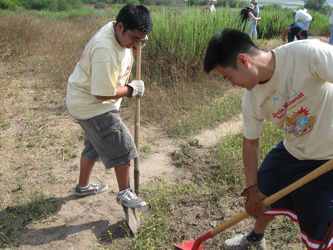 C4UQ: What happens to the non-native vegetation you and your volunteers remove?
C4UQ: What happens to the non-native vegetation you and your volunteers remove?
The invasive plant material we remove is often left on site, without flowers or seeds, to decompose and replace nutrients in the soil. Some of the material, mostly flowers and seeds, is bagged and taken off the site. This material ends up either in mainstream waste collection, or is taken to a green waste dump where the plant material is composted using heat to kill invasive seeds.
C4UQ: Will you share a success story directly related to your work?
As the story goes, we had recently completed installing native plants in a site when the rabbits began to nibble on the leaves. A day or so later, a volunteer noticed a bobcat, a species that is more recently populating the bay again after a long absence, catching a rabbit in the same restoration site. Instant food chain!
One particular female bobcat, "Babe", has used the Upper Newport Bay for a birthing den and hunting ground for nearly 5 years now. While she makes her way around the surrounding neighborhoods as well, the bay is still home and we're happy to have her.
It's difficult when rabbits start eating all of our hard work, but it's nice to know that our effort is creating real change. We have to remember that all the work we do with plants is there to support the native wildlife communities. We share a borrowed rhyme with our volunteers: "Food, water, shelter and space: habitat is a wonderful place!"
C4UQ: What is your favorite native plant to foster and restore?
For purely selfish reasons, I like the blue-eyed grass (Sisyrinchium bellum). It's a gorgeous wildflower, an iris rather than a grass, with purple petals leading to a yellow center.
C4UQ: Which species prosper from a healthy local marsh?
Birds! The Upper Newport Bay is known for its birding opportunities when the winter migration is under way. The celebrity species is the light-footed clapper rail, an elusive year-round resident. I've only seen it six times although it lives in the low marsh very near the paved trail where people unknowingly drive, run, and bike by every single day.
A few plants we propagate that provide direct habitat for endangered species include California sagebrush (habitat for the California gnatcatcher), coast prickly pear (habitat for the cactus wren), and mulefat and arroyo willow (which create a thicket that is habitat for the least Bell's vireo). Knowing about the direct connection between the plants and these special bird species is very motivating for our volunteers and me.
Several years ago, osprey nested on top of a pole at the Back Bay Science Center for the first time in Orange County's recorded history. While the birds are present throughout the year catching their prey-fish-at the bay, none had ever used the bay to nest and raise its young. Since then, the same parent couple has returned successfully four years in a row. As I write this in December, they're beginning to build their nest again outside my window.
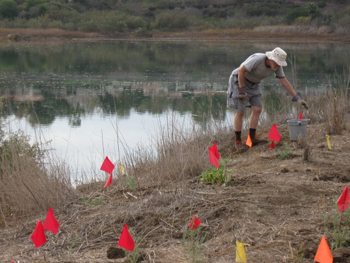 C4UQ: Why did you become dedicated to environmental stewardship?
C4UQ: Why did you become dedicated to environmental stewardship?
From my first camping trip in the Adirondacks of New York State—where I was scared witless by a ruffed grouse defending her nest—to monthly Boy Scout outings and leading adventure trips in college, my first love was outdoor recreation. A lot can be said for getting a child outdoors and letting a love develop from exposure to all things natural.
A key component in my journey was realizing I liked sharing what I found enjoyable about nature with other people. With that realization, I completed a master's degree in Environmental Education and have found opportunities to share my love of nature ever since. Of course, sharing nature and working to preserve and protect the natural spaces around us go hand in hand.
C4UQ: How does the future look for Upper Newport Bay?
In a word, complex. The health of the bay faces an uphill battle. It faces the effects of a highly urbanized watershed and the constant struggle between human use and habitat protection. There is hope, of course. I am proud of the growth I've seen in our volunteers some of whom had little interest in being outside at the bay when they began. Now they've become experts on the birds and the plants that they see on site. Upper Newport Bay is a jewel of open space in Orange County, amidst much development, for both wildlife and humans to enjoy. Our success truly lies in educating the public in order to amplify the work we do in the field. Growing volunteer knowledge, that they can share with new volunteers, is just as sustaining as seeing the plants grow.
For more information on the California Coastal Commission's Community-Based Habitat Restoration Program, visit the website.

